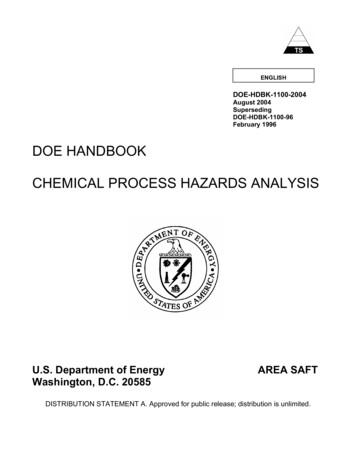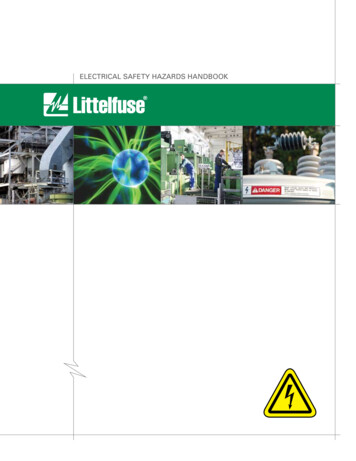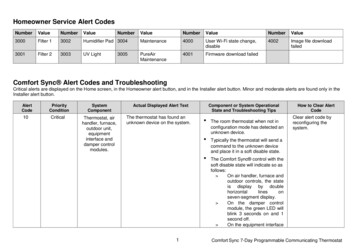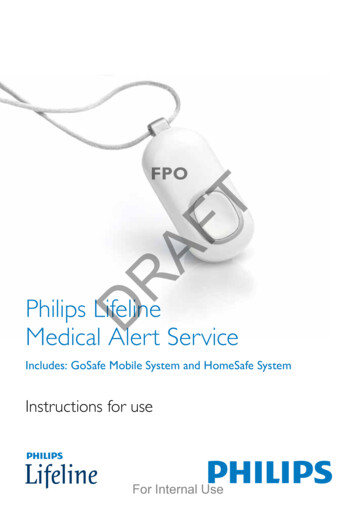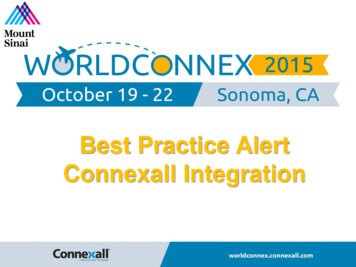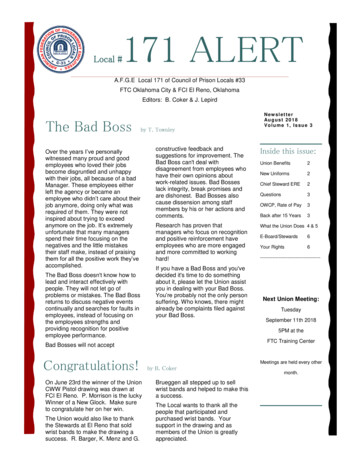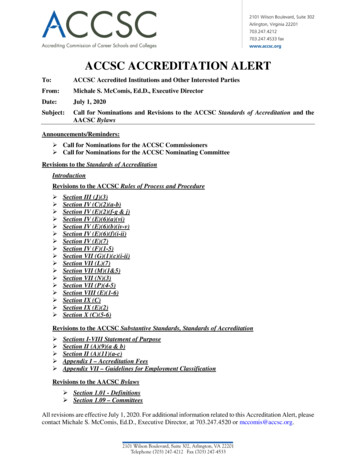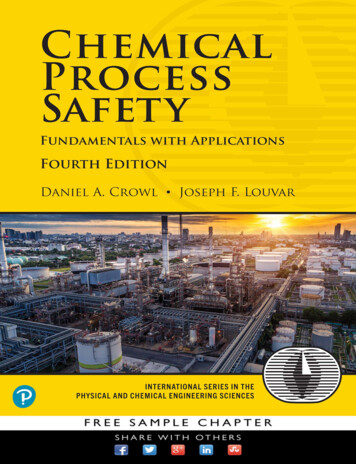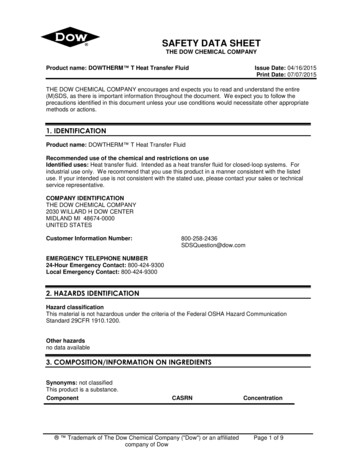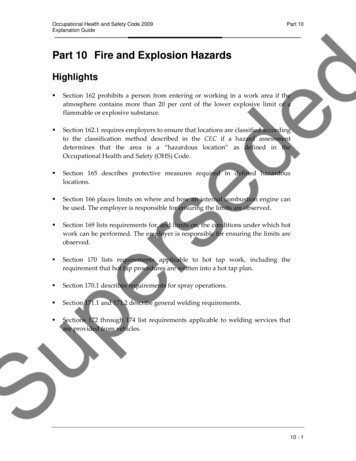
Transcription
United StatesOffice of Solid WasteEPA 550-F-01-009Environmental Protectionand Emergency ResponseAugust 2001Agency(5104A)www.epa.gov/ceppoHazards of Ammonia Releases atAmmonia Refrigeration Facilities (Update)The Environmental Protection Agency (EPA) is issuing this Alert as part of its ongoing effort to protecthuman health and the environment by preventing chemical accidents. We are striving to learn the causes andcontributing factors associated with chemical accidents and to prevent their recurrence. Major chemicalaccidents cannot be prevented solely through regulatory requirements. Rather, understanding thefundamental root causes, widely disseminating the lessons learned, and integrating these lessons learned intosafe operations are also required. EPA publishes Alerts to increase awareness of possible hazards. It isimportant that facilities, State Emergency Response Commissions (SERCs), Local Emergency PlanningCommittees (LEPCs), emergency responders, and others review this information and take appropriate stepsto minimize risk. This document does not substitute for EPA’s regulations, nor is it a regulation itself. Itcannot and does not impose legally binding requirements on EPA, states, or the regulated community, andthe measures it describes may not apply to a particular situation based upon the circumstances. Thisguidance does not represent final agency action and may change in the future, as appropriate.ALERTChemical SafetyProblemAnhydrous ammonia is used as arefrigerant in mechanical compressionsystems at a large number of industrialfacilities. Ammonia is a toxic gas underambient conditions. Many parts of arefrigeration system contain ammonialiquefied under pressure. Releases ofammonia have the potential for harmfuleffects on workers and the public. If theammonia is under pressure, risk ofexposure increases since larger quantitiesof the refrigerant have the potential forrapid release into the air. Also, someexplosions have been attributed to releasesof ammonia contaminated with lubricatingoil. This Alert further discusses thesepotential hazards and the steps that can betaken to minimize risks. This Alert shouldbe reviewed by personnel who operate andmaintain refrigeration systems, managersof facilities, and emergency responders(e.g., haz mat teams).AccidentsA number of accidental releases ofammonia have occurred from refrigerationfacilities in the past. Releases result from anumber of situations that include plantupsets leading to over pressure conditionsand lifting of pressure relief valves; sealleaks from rotating shafts and valve stems;refrigerant piping failures due to loss ofmechanical integrity from corrosion;physical damage of system componentsfrom equipment collisions; hydraulicshock; and hose failures that occur duringammonia deliveries. Some of theseincidents have led to injury and fatalitieson-site as well as causing adverse off-siteconsequences. In addition to risks ofpersonal injury, ammonia releases have thepotential of causing significant collateraldamage including: product loss due toammonia contamination, interruption ofrefrigeration capacity, product loss due torefrigeration interruption, and potential forequipment and property damage resultingfrom the incident. In many cases, ammoniareleases have resulted in multi-milliondollar financial losses. The Factory MutualLoss Prevention Data Bulletin 12-61describes several incidents with propertydamage ranging from 100,000 to 1,000,000 per incident. The followingdescribes several recent incidents in moredetail.One type of accident that is easilypreventable is equipment failure due tophysical impact. In a 1992 incident at ameat packing plant, a forklift struck andruptured a pipe carrying ammonia for
2HAZARDS OF AMMONIA RELEASES AT AMMONIA REFRIGERATION FACILITIES (UPDATE)refrigeration. Workers were evacuated when theleak was detected. A short time later, an explosionoccurred that caused extensive damage, includinglarge holes in two sides of the building. The forkliftwas believed to be the source of ignition. In thisincident, physical barriers would have providedmechanical protection to the refrigeration systemand prevented a release.Another incident highlights the need for an adequatepreventive maintenance program and scheduling. Ina 1996 incident involving a cold storage warehousefacility, compressor oil pressure progressivelydropped during a long weekend. The low oilpressure cutout switch failed to shutdown thecompressor leading to a catastrophic failure as thecompressor tore itself apart. A significant release ofammonia ensued. Periodically testing allrefrigeration-related safety cutout switches isabsolutely necessary to minimize the likelihood ofsuch incidents.Two other incidents illustrate the potential forserious effects from accidental releases fromammonia refrigeration systems, although the causesof these releases were not reported. In a 1986incident in a packing plant slaughterhouse, arefrigeration line ruptured, releasing ammonia. Eightworkers were critically injured, suffering respiratoryburns from ammonia inhalation, and 17 others wereless severely hurt. A 1989 ammonia release in afrozen pizza plant led to the evacuation of nearly allof the 6,500 residents of the town where the plantwas located. The release started when an end cap ofa 16-inch suction line of the ammonia refrigerationsystem was knocked off. Up to 45,000 pounds ofammonia was released, forming a cloud 24 cityblocks long. About 50 area residents were taken tohospitals, where they were treated with oxygen andreleased, while dozens of others were treated withoxygen at evacuation centers.Hazard AwarenessAmmonia is used widely and in large quantities fora variety of purposes. More than 80% of ammoniaproduced is used for agricultural purposes; less thantwo percent is used for refrigeration. Ammonia cansafely be used as a refrigerant provided the system isproperly designed, constructed, operated, andmaintained. It is important to recognize, however,that ammonia is toxic and can be a hazard to humanhealth. It may be harmful if inhaled at highAUGUST 2001concentrations. The Occupational Safety and HealthAdministration (OSHA) Permissible Exposure Level(PEL) is 50 parts per million (ppm), 8-hour timeweighted average. Effects of inhalation of ammoniarange from irritation to severe respiratory injuries,with possible fatality at higher concentrations. TheNational Institute of Occupational Safety and Health(NIOSH) has established an Immediately Dangerousto Life and Health (IDLH) level of 300 ppm for thepurposes of respirator selection. Ammonia iscorrosive and exposure will result in a chemical-typeburn. Since ammonia is extremely hygroscopic, itreadily migrates to moist areas of the body such aseyes, nose, throat, and moist skin areas. Exposure toliquid ammonia will also result in frostbite since itstemperature at atmospheric pressure is –28ºF.The American Industrial Hygiene Association(AIHA) has developed Emergency Response PlanningGuidelines (ERPGs) for a number of substances toassist in planning for catastrophic releases to thecommunity. The ERPG-2 represents theconcentration below which it is believed nearly allindividuals could be exposed for up to one hourwithout irreversible or serious health effects. TheERPG-2 for ammonia is 200 ppm. EPA has adoptedthe ERPG-2 as the toxic endpoint for ammonia for theoffsite consequence analysis required by the RiskManagement Program (RMP) Rule under section112(r) of the Clean Air Act.In refrigeration systems, ammonia is liquefied underpressure. Any liquid ammonia released to theatmosphere will aerosolize producing a mixture ofliquid and vapor at a temperature of –28ºF. Thereleased ammonia rapidly absorbs moisture in the airand forms a dense, visible white cloud of ammoniumhydroxide. The dense mixture tends to travel alongthe ground rather than rapidly rising. This behaviormay increase the potential for exposure of workersand the public.Although pure ammonia vapors are not flammable atconcentrations of less than 16%, they may be a fireand explosion hazard at concentrations between 16and 25%. Mixtures involving ammonia contaminatedwith lubricating oil from the system, however, mayhave a much broader explosive range. A studyconducted to determine the influence of oil on theflammability limits of ammonia found that oil reducedthe lower flammability limit as low as 8%, dependingon the type and concentration of oil (Fenton, et al.,1995).
3HAZARDS OF AMMONIA RELEASES AT AMMONIA REFRIGERATION FACILITIES (UPDATE)An important property of ammonia is its pungentodor. The threshold concentration at whichammonia is detectable varies from person to person;however, ammonia can be usually detected atconcentrations in the range of 5 ppm to 50 ppm.Concentrations above about 100 ppm areuncomfortable to most people; concentrations in therange of 300 to 500 ppm will cause people to leavethe area immediately.Hazard ReductionThe Chemical Accident Prevention Group of EPA’sRegion III (Pennsylvania, Maryland, Virginia, WestVirginia, Delaware, and the District of Columbia)has been evaluating facilities in Region III withammonia refrigeration systems to gather informationon safety practices and technologies and to share itsknowledge with these facilities. Region III hasconducted more than 135 chemical safety auditsfrom 1995 to the present of both large and smallfacilities using ammonia for refrigeration. Inaddition, over the past 2 years, Region III hasconducted 32 Risk Management Program (RMP)audits of ammonia refrigeration systems to ensurecompliance with the RMP rule and 17 General DutyClause inspections of systems that are not coveredby the RMP regulation but had a near miss incident.(A brief explanation of the General Duty Clause andthe RMP Rule is found in the Statutes andRegulations Section of this Alert). To share theirfindings from the audits, including both thedeficiencies observed and the actions that facilitiesare taking to increase safety, Region III has madepresentations to the Refrigerating Engineers andTechnicians Association (RETA). This Alert isintended to communicate these findings to a wideraudience.Ammonia refrigeration facilities should be aware ofthe potential hazards of ammonia releases and of thesteps that can be taken to prevent such releases.They should be prepared to respond appropriately ifreleases do occur. Here are steps that ammoniarefrigeration facilities could take to prevent releasesand reduce the severity of releases that do occur: Establish training programs to ensure thatthe ammonia refrigeration system isoperated and maintained by knowledgeablepersonnel. Some organizations that provideammonia refrigeration education andAUGUST 2001training are listed in the Training ResourcesSection of this Alert. Consider using a spring-loaded ball valve(dead-man valve) in conjunction with the oildrain valve on all oil out pots (used to collectoil that migrates into system components) asan emergency stop valve. Develop and require refrigerationmaintenance personnel to follow written,standard procedures for maintaining thesystem including such routine procedures asoil draining. Consider developing in-housechecklists to guide maintenance personnelwhile they execute these procedures. Remove refrigeration oil from therefrigeration system on a regular basis. Neverremove oil directly from the refrigerationsystem without pumping down and properlyisolating that component. Provide barriers to protect refrigerationequipment, i.e., lines, valves, andrefrigeration coils, from impact in areaswhere forklifts are used. Consider integratingammonia refrigeration awareness anddiscussion of the risks of forklift accidentsthat can lead to ammonia releases as part of aformal forklift driver training program. Develop and maintain a written preventivemaintenance program and schedule based onthe manufacturers recommendations for all ofthe refrigeration equipment. The preventivemaintenance program should include, but notbe limited to:a) compressorsb) pumpsc) evaporatorsd) condenserse) control valvesf) all electrical safety(s), including1) high pressure cutouts2) high temperature cutouts3) low pressure cutouts4) low temperature cutouts5) low oil pressure cutouts6) automatic purge systemsg) ammonia detectorsh) emergency response equipment,including,1) air monitoring equipment
4HAZARDS OF AMMONIA RELEASES AT AMMONIA REFRIGERATION FACILITIES (UPDATE)2) self-contained breathingapparatus (SCBA)3) level A suit4) air- purifying respirators. Perform regular vibration testing oncompressors. Document and analyze resultsfor trends. Maintain a leak-free ammonia refrigerationsystem. Investigate all reports of anammonia odor and repair all leaksimmediately. Leak test all piping, valves,seals, flanges, etc., at least four times a year.Some methods which can be used for leaktesting are sulfur sticks, litmus paper, or aportable monitor equipped with a flexibleprobe. Consider installing ammonia detectors inareas where a substantial leak could occuror if the facility is not manned 24 hours/day.The ammonia detectors should be monitoredby a local alarm company or tied into a calldown system. Ensure that the ammoniadetectors are calibrated regularly against aknown standard. Check the operation ofammonia sensors and alarms regularly. Replace pressure relief valves (PRVs) on aregular schedule (consult ANSI/IIARStandard 2– Equipment, Design, andInstallation of Ammonia MechanicalRefrigerating Systems); documentreplacement dates by stamping thereplacement date onto each unit’s tag. Replace single PRVs with dual relief valveinstallations. A dual relief valve installationconsists of one three-way shut-off valvewith two pressure safety relief valves. Therequired use of dual relief valves (based onthe size of the vessel to be protected) isoutlined in ASHRAE Standard 15 – SafetyCode for Mechanical Refrigeration.Consider how the use of dual relief valveinstallations may facilitate the replacement,servicing, or testing of PRVs on a regularschedule – a three-way valve allows onePRV to be isolated while the other remainson-line to protect the vessel. This setupallows each PRV to be serviced, tested orreplaced on a regular basis without the needto pump down the system. AUGUST 2001For large systems with many PRVs, considerusing the arrangement shown in Exhibit 1 fordetecting leakage. This arrangement includesinstallation of a rupture disc upstream of eachPRV with a gauge port or transducer inbetween the disc and PRV and installation ofan ammonia sensor in the PRV commonmanifold. In case of leakage from a PRV, thesensor would set off an alarm. A check ofeither the pressure gauge or transducer signalwould permit easy identification of whichPRV has popped.Ensure that the ammonia refrigeration systemis routinely monitored. Consider using adaily engine room log, recording processparameters (e.g., temperature and pressurelevels) and reviewing the log on a regularbasis. Consider having the chief engineer andthe refrigeration technician sign the dailyengine room log. In designing new systemsor retrofitting existing systems, consider theuse of computer controls to monitor theprocess parameters. Keep an accurate record of the amount ofammonia that is purchased for the initialcharge to the refrigeration system(s) and theamount that is replaced. Consider keeping arecord of the amount of lubricating oil addedto the system and removed from the system.
5 HAZARDS OF AMMONIA RELEASES AT AMMONIA REFRIGERATION FACILITIES (UPDATE)Ensure that good housekeeping proceduresare followed in the compressor/recyclerooms.Ensure that refrigeration system lines andvalves are adequately identified (e.g., bycolor coding or labeling) by using an in house system.Properly post ammonia placards (i.e. NFPA704 NH3 diamond) and warning signs inareas where ammonia is being used as arefrigerant or being stored (for example,compressor room doors). Properly identifythe chemicals within the piping system(s);label all process piping, i.e. pipingcontaining ammonia, as “AMMONIA.”Label must use black letters with yellowbackground. (This requirement is not thesame as the in-house color coding system.)Periodically inspect all ammoniarefrigeration piping for failed insulation/vapor barrier, rust, and corrosion. Inspectany ammonia refrigeration pipingunderneath any failed insulation systems forrust and corrosion. Replace all deterioratedrefrigeration piping as needed. Protect allun-insulated refrigeration piping from rustand/or corrosion by cleaning, priming, andpainting with an appropriate coating. Carry out regular inspections of emergencyequipment and keep respirators, includingair-purifying and self-contained breathingapparatus (SCBA), and other equipment ingood shape; ensure that personnel aretrained in proper use of this equipment. ForSCBA, it is important to ensure that air isbone dry. For air-purifying respirators,replace cartridges as needed and checkexpiration dates. Consider using the compressor roomammonia detector to control the ventilationfans. Identify the king valve and other emergencyisolation valves with a large placard so thatthey can easily be identified by emergencyresponders, in case of an emergency. Thesevalves should be clearly indicated on thepiping and instrumentation diagrams(P&IDs) and/or process flow diagrams.AUGUST 2001 Establish emergency shutdown proceduresand instructions on what to do during andafter a power failure. Consider installing a solenoid valve in theking valve line operated by a switch locatedoutside of the compressor/recycle room. Establish written emergency procedures andinstructions on what to do in the event of anammonia release. Regularly conduct emergency response drills.Emergency response personnel should "suit up" as part of the drill process. As needed,members of the hazmat team should regularlysuit-up to sharpen their emergency responseskills. Stage a realistic emergency response spillexercise with the local fire company. Mount a compressor room ventilation fanmanual switch outside of the compressorroom and identify it with a placard for use inan emergency. Good practice would be tohave ventilation switches located outside andinside of each door to the compressor room. Mount windsocks in appropriate places andincorporate their use into the facilityemergency response plan. In addition to theemergency response plan, considerdeveloping additional materials (posters,signs, etc.) to provide useful information toemployees and emergency responders in caseof an emergency. In developing emergencyinformation, consider whether materialsshould be developed in languages other thanEnglish. Keep piping and instrumentation diagrams(P&IDs), process flow diagrams, ladderdiagrams, or single lines up-to-date andincorporate them into training programs foroperators. A good suggestion is to laminatethe P&ID and ladder diagrams and postnearby to the equipment. Frost accumulates on evaporator coils. Theevaporator can be "soft gassed" during thedefrost cycle by placing a smaller hot gassolenoid valve in parallel with the main hot
6HAZARDS OF AMMONIA RELEASES AT AMMONIA REFRIGERATION FACILITIES (UPDATE)gas solenoid valve. The smaller valve issequenced to open first; thereby, allowingthe evaporator pressure to rise slowly. Analternative approach is to use a motorizedfull port ball valve in the hot gas supply lineand open it slowly initially to accomplishthe soft gassing. Once the pressure in theevaporator is brought up, then fully open thevalve. For additional information, consultIIAR’s Ammonia Refrigeration PipingHandbook.ReferencesFactory Mutual. 1993. Loss Prevention DataBulletin 12-61 (April 1993).AUGUST 2001educational videos, short course, and an annualconference.110 North Glebe Road, Suite 250Arlington, VA 22201Tel: (703) 312-4200www.iiar.orgRefrigeration Engineers Technicians Association:offers self-study materials and a tieredcertification/evaluation program for refrigerationtechnicians/mechanics.700 W. Lake AvenueGlenview, IL 60025-1485Tel: (847) 375-4738www.reta.comFenton, D.L., K.S. Chapman, R.D. Kelley, and A.S.Khan. 1995. "Operating Characteristics of aflare/oxidizer for the disposal of ammonia from andindustrial refrigeration facility." ASHRAETransactions, 101 (2), pp. 463-475. Atlanta, GA:American Society of Heating, Refrigeration, andAir-Conditioning Engineers.Information ResourcesIIAR. 2000. Ammonia Refrigeration PipingHandbookCEPPO has prepared a general advisory on ammonia(OSWER 91-008.2 Series 8 No. 2), available at:www.epa.gov/ceppo/acc-his.html.Education and TrainingResourcesGarden City Community College: offers hands-ontraining oriented toward operators of industrialammonia refrigeration systems and PSM/RMPimplementation classes.801 Campus DriveGarden City, Kansas 67846Tel: (620) 276-9520www.nh3gccc.comIndustrial Refrigeration Consortium (IRC) at theUniversity of Wisconsin-Madison: this universityindustry partnership offers educational opportunitiesand refrigeration-related resources.949 E. Washington Avenue, Suite 2Madison, WI 53703Tel:(608) 262-8220(866) 635 - 4721 Toll-freewww.irc.wisc.eduInternational Institute of Ammonia Refrigeration(IIAR): offers ammonia refrigeration-relatedGeneral ReferencesOSHA has a web site with information on ammoniarefrigeration and process safety: www.slc.osha rial Refrigeration Consortium (IRC )Headquartered at the University of WisconsinMadison, the IRC is a university-industry partnershipaimed at improving safety, efficiency, andproductivity of industrial refrigeration systems andtechnologies. The IRC conducts applied research,offers refrigeration training, and provides technicalassistance to refrigeration end-users. The IRCmaintains a website with additional information andresources related to ammonia refrigeration at:www.irc.wisc.edu.Statutes and RegulationsThe following are a list of federal statutes andregulations related to process safety, accidentprevention, emergency planning, and releasereporting.EPAClean Air Act (CAA) General Duty Clause [Section 112(r) of theAct]- Facilities have a general duty to prevent
7HAZARDS OF AMMONIA RELEASES AT AMMONIA REFRIGERATION FACILITIES (UPDATE)and mitigate accidental releases ofextremely hazardous substances, includingammonia.AUGUST 2001Federal or State emergency responseauthorities.OSHA Risk Management Program (RMP) Rule [40CFR 68]- Facilities that have anhydrousammonia in quantities greater than 10,000pounds are required to develop a hazardassessment, a prevention program, and anemergency response program. EPA hasdeveloped a model guidance to assistammonia refrigeration facilities complywith the RMP rule. Process Safety Management (PSM) Standard[29 CFR 1910] Ammonia (anhydrous) islisted as a highly hazardous substance.Facilities that have ammonia in quantities ator above the threshold quantity of 10,000pounds are subject to a number ofrequirements for management of hazards,including performing a process hazardsanalysis and maintaining mechanical integrityof equipment. Hazard Communication [29 CFR1910.1200] -Requires that the potentialhazards of toxic and hazardous chemicals beevaluated and that employers transmit thisinformation to their employees.Emergency Planning and Community Right-toKnow Act (EPCRA) Emergency Planning [40 CFR Part 355] Facilities that have ammonia at or above500 pounds must report to their LEPC andSERC and comply with certainrequirements for emergency planning. Emergency Release Notification [40 CFRPart 355]- Facilities that release 100 poundsor more of ammonia must immediatelyreport the release to the LEPC and theSERC. Hazardous Chemical Reporting [40 CFRPart 370]- Facilities that have ammonia at orabove 500 pounds must submit a MSDS totheir LEPC, SERC, and local firedepartment and comply with the Tier I/ TierII inventory reporting requirements.Toxic Chemicals Release Inventory [40CFR Part 372] - Manufacturing businesseswith ten or more employees thatmanufacture, process, or otherwise useammonia above an applicable thresholdmust file annually a Toxic ChemicalRelease form with EPA and the state.Comprehensive Environmental Response,Compensation, and Liability Act (CERCLA) Hazardous Substance Release Reporting [40CFR Part 302]- Facilities must report to theNational Response Center (NRC) anyenvironmental release of ammonia whichexceeds 100 pounds. A release may triggera response by EPA, or by one or moreFor additional information, contact OSHA PublicInformation at (202) 219- 8151.Web site: http://www.osha.govCodes and StandardsThere are a number of American National StandardsInstitute (ANSI) Standards available for refrigerationsystems. Some examples are given below.ANSI/ASHRAE Standard 15-1994 - Safety Code forMechanical RefrigerationAvailable for purchase from the American Society ofHeating, Refrigerating and Air-ConditioningEngineers (ASHRAE) International Headquarters,1791 Tullie Circle, NE, Atlanta, GA 30329-2305.Customer service: 1-800-527- 4723ANSI/IIAR 2-1992 - Equipment, Design, andInstallation of Ammonia Mechanical RefrigerationSystemsAvailable from the International Institute of AmmoniaRefrigeration (IIAR)1200 19th Street, NWSuite 300Washington, DC 22036-2422(202) 857-1110Web site: http://www.iiar.org
8HAZARDS OF AMMONIA RELEASES AT AMMONIA REFRIGERATION FACILITIES (UPDATE)ISO 5149-1993 - Mechanical Refrigerating SystemsUsed for Cooling and Heating -- SafetyRequirementsAvailable from the American National StandardsInstitute (ANSI)11 West 42nd StreetNew York, NY 10036(212) 642-4900AUGUST 2001For More Information.Contact the RCRA, Superfund, and EPCRA CallCenter(800) 424-9346 or (703) 412-9810TDD (800) 553-7672Monday-Friday, 9 AM to 6 PM, Eastern TimeWeb site: http://www.ansi.org*************Visit The CEPPO Home Page:http://www.epa.gov/ceppo/NOTICEThe statements in this document are intended solely as guidance. This document does not substitute forEPA's or other agency regulations, nor is it a regulation itself. Site-specific application of the guidance mayvary depending on process activities, and may not apply to a given situation. EPA may revoke, modify, orsuspend this guidance in the future, as appropriate.
fundamental root causes, widely disse minating the lessons learned, and in tegrating these lessons learned into . systems at a large number of industrial facilities. Ammonia is a toxic gas under ambient conditions. Many parts of a . The American Industrial Hygiene Association (AIHA)
